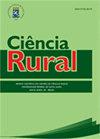Whole and ground sorghum replacing corn on the performance of carcass parts and relative weight of 28-day-old turkey offal
IF 0.9
4区 农林科学
Q3 AGRONOMY
引用次数: 1
Abstract
ABSTRACT: The study evaluated the effects of replacing corn with whole and ground sorghum on the zootechnical performance of turkeys fed from one to 28 days of age. A total of 3,960 male Nicholas turkeys were used, divided into six treatments: A) Whole sorghum (100%Sw); B) Ground corn (100%Cg); C) 75% Ground Corn + 25% Ground Sorghum (75%Cg/25%Sg); D) 50% Ground Corn + 50% Ground Sorghum (50%Cg/50%Sg); E) 25% Ground Corn + 75% Ground Sorghum (25%Cg/75%SG) and F) Ground Sorghum (100%Sg). At seven days, live weight was the same between treatments (164 g per bird). At 28 days, the percentage of breast, thigh-drumstick, and wings remained constant in the corn-based diet or partial and total replacements by ground or whole sorghum grain. The length of the small intestine was shorter in treatments B and C. The digestibility of the lipid fraction of the diet (DEE) was significantly higher in the diet with ground sorghum. The treatment based on ground sorghum grain showed the same result for ground corn in the dry matter (DM) and mineral matter (MM DM%) composition of the turkey carcass at 28 days. Ground sorghum influenced the lipid portion of the carcasses (EE DM%). Thus, it is concluded that whole sorghum grain presented the same results as ground sorghum and ground corn for zootechnical performance, carcass muscle mass, and viscera morphometry in turkeys at 28 days of age.全高粱和高粱粉替代玉米对28日龄火鸡内脏各部位性能和相对重量的影响
摘要:本试验旨在研究全高粱和高粱粉替代玉米对1 ~ 28日龄火鸡动物生产性能的影响。选用雄性尼古拉斯火鸡3960只,分为6个处理:A)全高粱(100%Sw);B)碾碎玉米(100%Cg);C) 75%玉米粉+ 25%高粱粉(75% cg /25% sg);D) 50%玉米粉+ 50%高粱粉(50% cg /50% sg);E) 25%玉米粉+ 75%高粱粉(25% cg /75% sg)和F)高粱粉(100%Sg)。第7天,两个处理的活重相同(每只鸡164 g)。28 d时,以玉米为基础的饲粮或部分或全部用高粱粉或全粒替代的饲粮中,鸡胸肉、腿腿肉和鸡翅的比例保持不变。处理B和处理c的小肠长度较短。饲粮中添加高粱粉显著提高了饲粮脂质部分(DEE)的消化率。高粱粉处理对28 d火鸡胴体干物质(DM)和矿物物质(MM DM%)组成的影响与玉米粉处理相同。高粱粉对胴体脂质部分(EE DM%)有影响。由此得出结论,在28日龄火鸡的动物技术性能、胴体肌肉质量和内脏形态测量方面,全高粱籽粒与高粱粉和玉米粉具有相同的结果。
本文章由计算机程序翻译,如有差异,请以英文原文为准。
求助全文
约1分钟内获得全文
求助全文
来源期刊

Ciencia Rural
AGRONOMY-
CiteScore
1.70
自引率
0.00%
发文量
233
审稿时长
2-4 weeks
期刊介绍:
The purpose of Ciência Rural is to publish the results of original research, note and reviews which contribute significantly to knowledge in Agricultural Sciences. Preference will be given to original articles that develop news concepts or experimental approaches and are not merely repositories of scientific data. The decison of acceptance for publication lies with the Editors and is based on the recommendations of Editorial Comission, Area Committee and/ or ad hoc reviewers. The editors and reviewers are external to the institution.
 求助内容:
求助内容: 应助结果提醒方式:
应助结果提醒方式:


